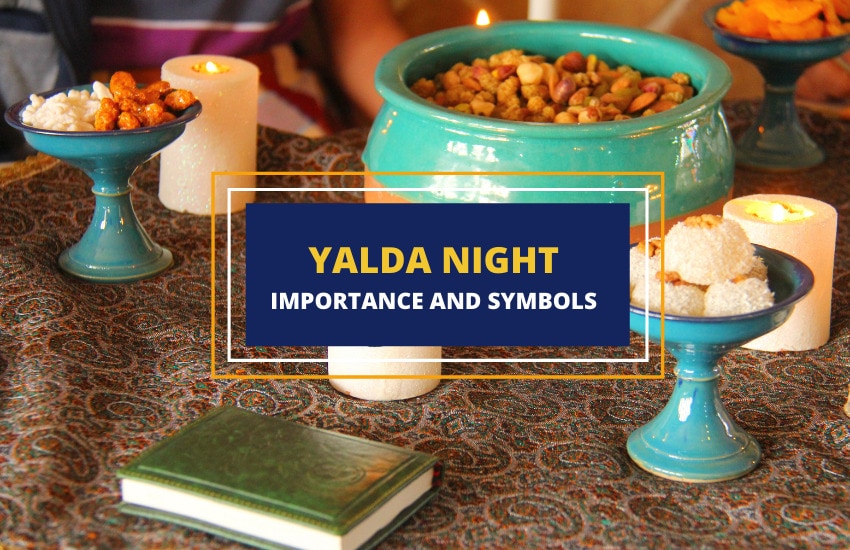
Table of Contents
Yalda Night, also called Shab-e Yalda, or by its original name – Shab-e Chelleh, is one of the oldest holidays in Iran and in the world as a whole. Celebrated on December 21 every year, the Yalda Night marks the winter solstice in Central Asia – the day of the year when the night is longest and the day is shortest.
It’s also the night that separates the Iranian autumn and winter, or the night that separates the first 40-day part of winter from the second 40-day part, depending on how you want to look at it.
What Does Yalda Night Symbolize?
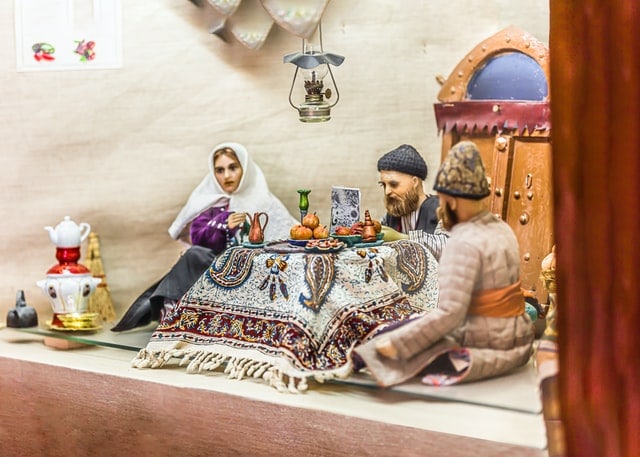
Like most other people around the world, the ancient Iranians celebrated most seasonal changes and ascribed a large number of religious and symbolic meaning to them. In the case of the Yalda Night, the people of Iran believed this is the night of the Sun’s rebirth.
The reasoning was very simple – each day after the Yalda Night gets longer and longer at the expense of the nights which keep getting shorter.
So, the Yalda Night symbolizes the triumph of the Sun over the Darkness. Despite the fact that the incoming 40 days after the Yalda Night are technically the coldest and harshest in the year, the Yalda Night still symbolizes the hope of the warmer and longer spring and summer days that will inevitably come as the Sun reconquers the day from the Darkness.
This is very similar to the ancient Celtic festival of Yule, which is celebrated on the same day as Yalda and in the same spirit. Notice that even the names are similar, and it’s likely that the festival of Yalda influenced Yule.
How is the Yalda Night Celebrated?
Just like Christians celebrate Christmas by getting together with their families, Iranian and other Central Asian people celebrate the Yalda Night with their families too.
They get together around the Korsis – a short and square-shaped table – to eat various dried and fresh fruits such as pomegranates, watermelons, grapes, persimmon, sweet melons, apples, and others. Fresh and dried nuts were also added to the table as were various meals, typically native to the particular city or village.
Pomegranates are especially important as they are believed to symbolize birth, revival, and the cycle of life. Their hard outer cover is the “dawn” or “birth” while the bright red and delicious seeds inside are the “glow of life”.
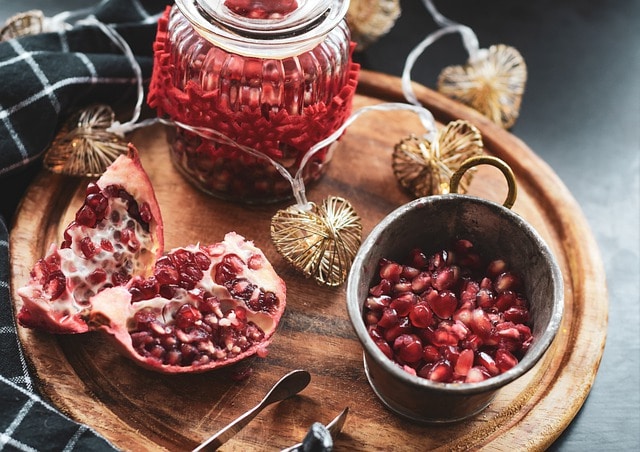
Eating fruits on the Yalda Night, particularly fresh fruits, is important as this holiday is meant to be the triumph of the Sun over the Darkness. Even though it is the dead of winter, the Iranian people preferred to see it as a positive – as the end of the Darkness’ advance on the Light. So, having fresh fruits on the table was crucial to emphasize “Life’s victory”.
While eating, the people would play traditional Iranian games such as chess, backgammon, and others. They would also tell old stories of their ancestors, reading from epics such as the Divan-e-Hafez and Shahnameh.
Divan-e-Hafez is a collection of old poems written in Farsi and composed by the most famous Persian poet known as Hafez. They are viewed as most sacred by the Iranian people and many of them are connected to the Yalda Night.
There is also the custom called Faal-a-Hafez which uses the Divan-e-Hafez for a type of fortune telling. According to the custom, people make a wish and open the Divan-e-Hafez on a random page. Then, they read Hafez’s poem on that page and interpret its meaning to see whether their wish will come true.
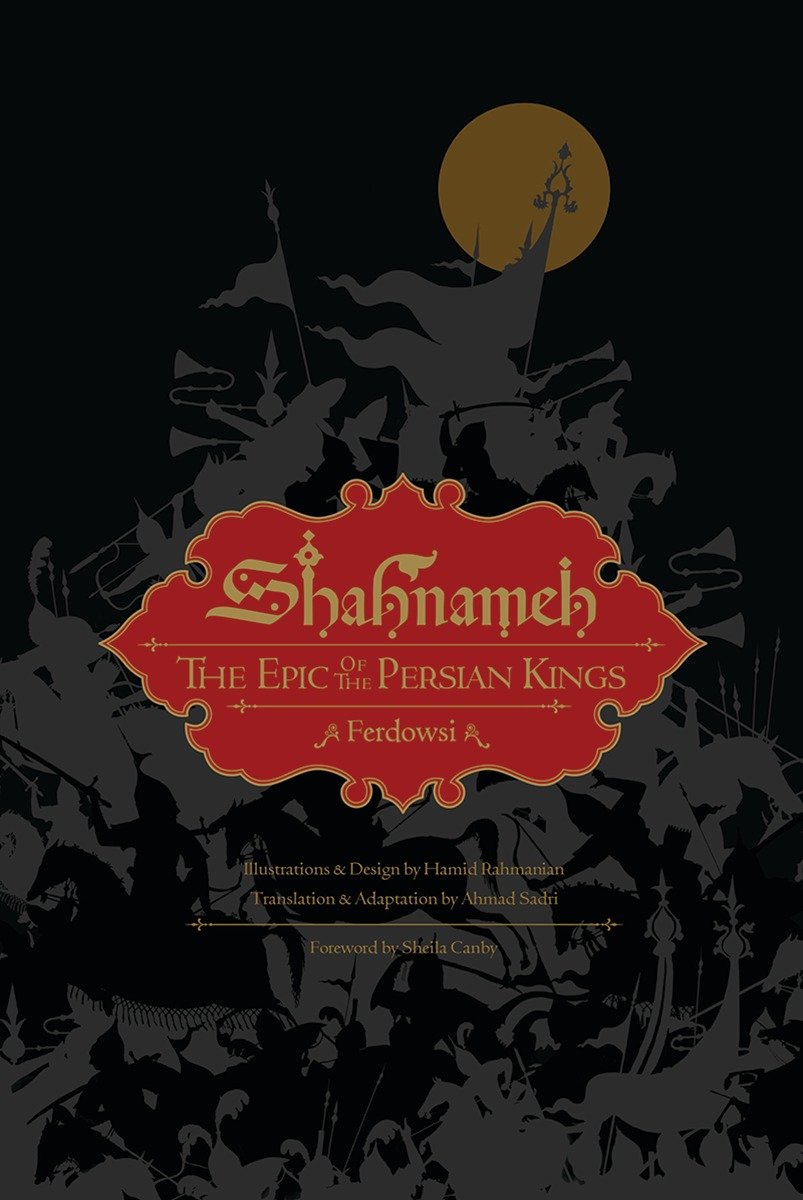
The Shahnameh, on the other hand, is the famous Persian Book of Kings. It’s written by the Persian poet Ferdowsi and contains various ancient Iranian myths and legends.
All this creates an atmosphere of warmth, freshness, kindness, love, and happiness on the Yalda Night.
What Do the Yalda Night’s Names Mean?
The original name of Yalda Night was Shab-e Chelleh and it meant The Night of Forty. Chelleh meant Forty and that referred to the fact that the winter solstice was what divided the first and milder half of the cold season with the latter 40 days of harsh winter.
As for Shab-e Yalda, this literally means Night of Yalda. The word Yalda itself is a Syriac word and means Birth, as the Yalda Night symbolizes the birth/rebirth of the Sun. The ancient Iranian Zoroastrian followers of Mithra used the word Yalda specifically when talking about the birth of Mithra. It’s not exactly clear when that word came to be used instead of Shab-e Chelleh, however.
Is the Yalda Night a Muslim holiday?
As best as we can tell, Shab-e Cheleh has been celebrated for almost 8,000 years, possibly longer. As such, the Yalda Night isn’t really a Muslim calendar as Islam is only about 1,400 years old.
Instead, the Yalda Night’s origins rest in the ancient religion of Zoroastrianism. According to it, the Yalda Night and the Sun’s birthday foretell the arrival of the deity of Light Mithra or Mehr.
However, even though Iran today is a 99% Muslim country, the Yalda Night Zoroastrianism holiday is still widely celebrated as one of the biggest holidays there.
This is very similar to how Christians celebrate the 25th of December as Christmas, even though it was originally a European pagan holiday of Saturnalia, celebrating the winter solstice there.
The difference is that in the case of the Yalda Night, the original holiday was kept more or less intact and wasn’t replaced with a new Muslim holiday.
Is Yalda Night Only Celebrated in Iran?
While the Yalda Night tradition seems to have started in Iran, it has spread across large parts of Central Asia as well. This is likely due to the Parthian (also known as Persian) and Sassanid Empires which ruled most of the region between the 6th century BCE and the 7th century AD when the region was conquered by Muslims.
Even before the Parthian Empire, many nomadic tribes such as the Scythians, Medes, and, of course, the Persians, moved through the Iranian plateau for thousands of years. As a result, religious practices, and holidays such as Zoroastrianism and the Yalda Night were spread across the region. Today, most Central Asian countries celebrate the Yalda Night including Afghanistan, Tajikistan, Turkmenistan, Uzbekistan, Iraqi Kurdistan, as well as a few Caucasian states like Armenia and Azerbaijan. The roughly 14 million Kurdish people in Turkey also celebrate the Yalda Night.
This means that, by a very rough estimate, this holiday is celebrated by about 200 million people across Central Asia and the Middle East. Countless ethnic Iranians across Europe, the US, and the rest of the world also often celebrate the Yalda Night, as the Christians around them prepare to celebrate Christmas and their Jewish neighbors celebrate Hanukkah.
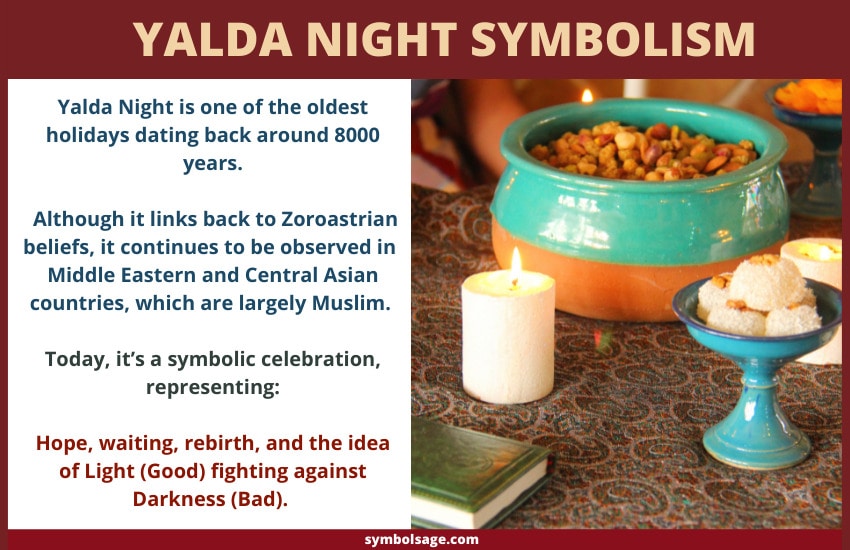
Wrapping Up
Yalda Night is one of the oldest holidays that is still celebrated, dating back around 8000 years. Although it links back to Zoroastrian beliefs, it continues to be observed in Middle Eastern and Central Asian countries, which are largely Muslim. Today, it’s a symbolic celebration, representing hope, waiting, loneliness, and the idea of Light (Good) fighting against Darkness (Bad).








